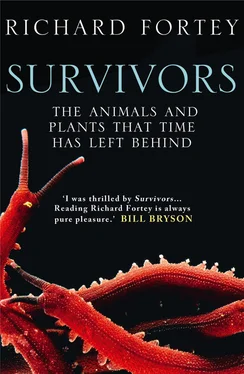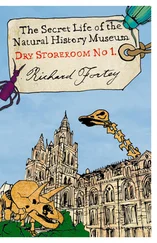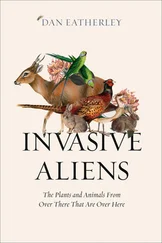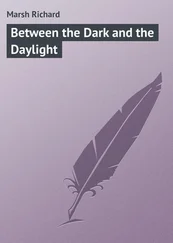1 ...7 8 9 11 12 13 ...21 I have to understand New Zealand’s long history before my search for an animal that has survived from a period even earlier than the first appearance of the horseshoe crabs. My quarry is the velvet worm. This creature will help us climb downwards to a still lower branch of the evolutionary tree. George Gibbs from the University of Wellington is my guide. He knows the secretive ways of these elusive animals. We drive out along Route 1, west of Wellington on the southern edge of the North Island, prior to walking up the Akatara Ridge along a small country track. The whole area was milled in the 1930s and 1940s so the mature podocarp forest has all gone, but there is secondary growth of tree ferns and rimu and Protea in a dense thicket. Some of the common native birds have adapted to the new circumstances. We hear the distinctive whistle and churr of the tui as we park the car. New Zealand birds usually have a distinctive and attractive song, even those that are unspectacular to look at. As we walk up the track I notice another survivor, the lowly herb Lycopodium, growing on the bank, a plant we shall meet again. It is a steady climb, though hardly taxing. Towards the top of the track the landscape opens out into gently rolling, wooded farmland. A scattering of cows and white sheep graze on the cleared, grassy hillsides, and dotted among them are Californian pines. The wind blows through the trees with a sound like the gentle crash of waves. The ‘old homestead’ proves to be an antique wooden building in the bottom of a small hollow surrounded by a circle of ageing pine trees. George locates the bleached remnants of rotten pine logs lying on the ground nearby. For some reason they had not been tidied away after felling, so they have had the opportunity slowly to break down in situ. Selecting one log, it soon becomes apparent that inside its pale exterior the decaying wood is rusty red and fibrous. George starts beating at it with a small mattock brought along especially for the purpose. I cannot help leaning expectantly over his shoulder. Each hack of the instrument beats away ten million years of geological time. Can the velvet worm be hiding inside this curious sarcophagus? Where is its time capsule?
But the first log yields nothing. A second log is soon under attack. It seems softer somehow, more decayed. As the wood splits easily apart tiny white termites are exposed to the air, looking something like pallid ants, almost transparently delicate. They move slowly, as if stunned by being exposed suddenly to bright light: they are creatures of habitual darkness. Their little antennae can be seen waving furiously. Termites are wood eaters hiding deep inside the log, living in chambers they make running along its ‘grain’. We had opened up their secret world. And then we see there’s something else, something caterpillar-like, hiding in the termites’ tunnels. It shrinks away as if it does not want to be seen, or as if light is somehow an embarrassment to it. George coaxes it expertly into full view: it’s the velvet worm!
This is the creature we had come all this way to find: Peripatus novae-zealandiae to give it its scientific name. Because it does not move very fast, it proves relatively easy to catch and bring out into the light. It is indeed about the size of a very large caterpillar, light brownish and with a stripe running down its back. I gingerly touch it and find it soft and giving – if hardly velvety. George soon finds a second worm hiding away inside the log, and then a third; they evidently do not mind one another’s company. They attempt to twist away from us in a most peculiar fashion: they seem to be capable of drastically changing their length. It looks as if they can stretch or squash like concertinas. They are highly flexible, too, and one of them turns into a tight ‘S’ shape with no trouble. ‘That’s not like a caterpillar’, I say to George. He grins back at me, sharing my pleasure in the discovery. They clearly have a front and a back, for at the forward end are a prominent pair of antennae – which lead the way the animals want to flee. Their movement is not worm-like at all, despite their name. It is accomplished by means of little conical stumpy legs on either side of the long body. On the hand these make an oddly prickly-tickly sensation. Velvet worms are clearly very odd invertebrates.
The Peripatus animals evidently live alongside the termites inside rotting pine logs; indeed, they feed on the little insects, pursuing them through the chambers inside, doubtless detecting them with their sensitive ‘feelers’. They trap their prey by means of a sticky slime produced in special glands. Nothing else in nature feeds in exactly the same way. One of George’s students proved that the slime only entraps termites of the right size – not too big to escape, not too small to be uneconomic – after all, slime is protein, and that is expensive for the creatures to make. I try out the feel of it; it is distinctly tacky, and it must be like glue to a termite. Both the velvet worm and the termites shun the sunlight with good reason. They lose water very rapidly through their thin ‘skins’. The velvet worm is little more than a bag of fluid surrounded by a membrane. In bright sun it would soon dry to a crisp. Inside the hermetic and lightless world of a decaying pine tree the relative humidity is nearly always 100 per cent and it is perfectly safe.
Poking about some more in the rotten wood we make another discovery: baby velvet worms. They are only about one centimetre long, and pale in colour, but they seem to be exact small versions of the large ones. I presume they must eat suitably diminutive termites. The worms grow continuously to achieve adult size, blowing up like balloons. The velvet worm actually gives birth to live young, and the ones we saw may have been newly born. This is unusual among invertebrates, and even among vertebrates is only characteristic of mammals (and a few specialised reptiles). The eggs of this particular velvet worm are few in number, and large and yolky, thus allowing for further embryonic development within the female; only three or four young are born at one time. There are two ‘litters’ a year. Since the animals live for three years they only have about twenty offspring, which is an extraordinarily small number when one remembers that most arthropods, for example, lay thousands of eggs: recall our horseshoe crabs. The most prolific velvet worm species produces no more than forty young a year. It seems that Peripatus is an animal with a personality all its own.
Looking a little more closely at the velvet worm, the first thing to notice is that the body seems to be made out of many rings that encircle the body, even the legs and antennae. They remind me of the Michelin Man, supreme advertising logo of the famous tyre company, all dressed up in his bands of rubber. It is this distinctive structure that accounts for the body’s elastic properties. Muscles circle the body cavity inside the skin. Then it is obvious that this is a segmented animal rather like a trilobite, with lots of similar units repeated along the length of the body. Each body segment carries a pair of those stumpy legs. Among living species of velvet worms the number of segments varies quite widely, but, biologically speaking, that is only a matter of tacking on extra identical units, and does not require massive tinkering at the genetic level. To prove this, there is even one velvet worm species that can have between twenty-nine and forty-three body segments. The short, stumpy legs propel the animal along by working in sequence in waves, a common feature among segmented animals. From the side, it looks as if one leg hands on a motion to its neighbour progressively in a common direction. Forward movement would obviously not be possible if legs pushed forwards entirely at random; cooperation is required. The legs remind me of the limbs of a child’s stuffed toy, rather like those belonging to Piglet as illustrated by E. H. Shepard in The House at Pooh Corner, but they work well enough to catch up with termites. After all, one does not need a Maserati to overtake a donkey. Looking more closely at the surface of the ‘skin’ each of the body rings carries a line of protuberances, giving the external surface a knobbly appearance, especially on its upper side – these are known as papillae (they may have even smaller secondary papillae upon them). The patterns of the papillae vary between velvet worm species, as does the overall colour. There is one magnificently blue species elsewhere in New Zealand.
Читать дальше












